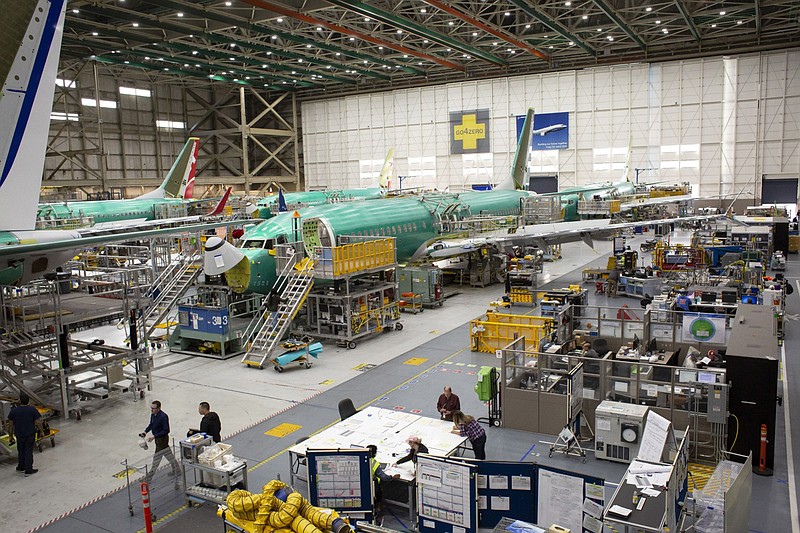Boeing is preparing to bolster the long-term safety of its troubled 737 Max with technology borrowed from space vehicles and urban drones that can provide data to help back up its sensors.
The system -- known as synthetic air data -- takes existing information on the aircraft, runs it through a computer program and produces readings that mimic what costly additional sensors provide.
Added as a result of pressure from overseas regulators, it would reduce the risk of accidents such as those on the Max. But it would also address a wide range of deadly air crashes triggered by confusing cockpit readings, according to engineers and academic research. It's already proved its value on Boeing's 787, and Airbus is adopting similar techniques in its aircraft.
"The reason why myself and a bunch of others are looking at it is it does have the promise to enhance safety," said Demoz Gebre-Egziabher, an aerospace engineering professor at the University of Minnesota who is researching such systems.
At the same time, Gebre-Egziabher and others caution that the technology involves knotty challenges, and it's most likely not something Boeing can slap on the Max in a few months. "The algorithms are complicated and certifying them is a bear," Gebre-Egziabher said.
BACKUP FOR SENSORS
Boeing's best-selling plane, an updated version of the decades-old 737 family, was grounded in March 2019 after two crashes in less than five months left a total of 346 people dead. The chain of events leading to both crashes was prompted by the failure of sensors known as angle-of-attack vanes, and the new technology would provide redundancy for those readings without adding additional sensors, which are costly.
U.S. aviation regulators this month said they've tentatively accepted Boeing's sweeping redesign of the Max without the new technology, meaning the plane could be approved to fly again as soon as this fall. The fixes also meet the standards of other nations, the Federal Aviation Administration said.
The new suite of virtual sensors Boeing is planning to add to the plane is a result of demands by the European Aviation Safety Agency, which has repeatedly said it wants even more protections for the Max.
In a compromise, the European agency has agreed not to hold up the plane's recertification, but it, along with the FAA, is insisting that Boeing make improvements in the future and spell out how it plans to do so before final approval, said a person familiar with the deliberations who wasn't permitted to talk about them publicly.
Specifically, the European agency wants more backups for the angle-of-attack vanes. The Max, like other Boeing aircraft, has two angle-of-attack sensors, while Airbus planes have three.
Discussions on the issues are still underway and the agency said in a statement that it can't comment.
Despite the differences in sensors, Airbus and Boeing models have nearly identical accident rates, which overall are at all-time lows. But both manufacturers have suffered incidents and accidents as a result of angle-of-attack failures.
Even with the fixes to the Max, a single angle-of-attack sensor failure can trigger multiple confusing alarms in the cockpit. Adding a third such sensor -- a small wind vane that measures whether the jet's nose is pointed above or below the oncoming air -- could help mitigate that, European regulators have said. Such an addition would be costly and time-consuming, though.
MOTION DETECTOR SOLUTION
However, breakthroughs in recent decades have made it possible to produce accurate estimates of angle of attack without a new sensor, Gebre-Egziabher said. These systems can also replicate a plane's speed and other flight data, according to academic research and uses on existing aircraft.
Improvements in motion detectors -- highly sophisticated cousins of the devices in smartphones that measure how many steps you've taken -- can monitor a plane's dips and turns. GPS position data helps ensure accuracy. And modern computers allow the data to be knit together using physics formulas to show speed and how the plane is behaving, including its angle of attack.
Peter Lemme, a consultant who worked on aircraft control systems for earlier Boeing models, cautioned that such systems remain notoriously complex.
"It's easy to talk about but it's hard to do," Lemme said. "This is not a casual undertaking. It will probably take at least two years."
Not only must engineers ensure that the formulas they devise work in every scenario imaginable, but aviation software must be many times more reliable than in consumer products.
Adopting such a system also comes with controversy. A Boeing engineer last year filed an ethics complaint with the company charging his efforts to add synthetic readings to the Max during its development were blocked by managers opposed to the cost and complexity, according to a letter he wrote to Senate investigators.
Boeing said in a statement it doesn't comment on internal complaints from its employees. The company has also declined to comment on its work to add synthetic sensors to the Max, other than to say, "We continue to make steady progress towards safely returning the airplane to service."
